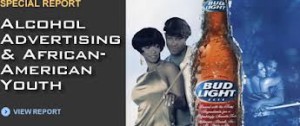African-American Youth Exposed to More Alcohol Advertising

African-American Youth Exposed to More Alcohol Advertising
In 2003, alcohol trade groups committed to placing ads for beer and distilled spirits in media only when underage kids comprise 30 percent or less of the audience. Nevertheless, among youth 12 to 20 years old, African-American kids are exposed to more magazine and television alcohol advertising than kids in general, according to the Center on Alcohol Marketing and Youth.
“The report’s central finding—that African-American youth are being over-exposed to alcohol advertising—is a result of two key phenomena,” said author David Jernigan, PhD, the director of CAMY. “First, brands are specifically targeting African-American audiences and, secondly, African-American media habits make them more vulnerable to alcohol advertising in general because of higher levels of media consumption.”
African-American youth saw 32 percent more alcohol advertising than all youth in national magazines during 2008.
African-American youth were exposed to 17 percent more TV alcohol advertising per capita than all youth in 2009, including 20 percent more exposure to distilled spirits advertising.
While African-American youth heard 26 percent less radio advertising in 2009 for alcohol than all youth, they heard 32 percent more radio advertising for distilled spirits.
If those kids happen to live in disadvantaged neighborhoods, they may be susceptible to a complex interaction between neighborhood disadvantage and growing up dealing with problem drinking, according to a report the Journal of Studies on Alcohol and Drugs.
“There are a lot of aspects of your environment that can affect your drinking behavior and what happens when you do choose to drink,” says lead researcher Katherine J. Karriker-Jaffe, Ph.D., of the Public Health Institute’s Alcohol Research Group in Emeryville, California.
While researchers found that of nearly 14,000 adults surveyed, those living in low-income neighborhoods were actually more likely to be non-drinkers than people in affluent neighborhoods, African Americans were more likely than their better-off counterparts to be heavy drinkers. And those black men (and white women) from poor neighborhoods who drank were more likely to suffer drinking-related “consequences” that include difficulty at work, physical fights, and run-ins with police.
While disadvantaged neighborhoods may have a lot of bars or stores to get alcohol, there are factors in those neighborhoods that do limit drinking, such as less disposable income or “cultural norms that frown on drinking,” that make point to a complex relationship between low-income neighborhoods disadvantage drinking. And it’s not clear yet why there are racial and gender differences, according to the report. One speculation is that for low-income black men, the higher rate of heavy drinking may be related to the multiple stressors. And the higher rate of “drinking consequences” could be explained by a larger police presence in low-income African-American neighborhoods.
Researcher Karriker-Jaffe notes that whatever the reasons for these findings, it does point to opportunities to intervene.
By D.A. Barber
